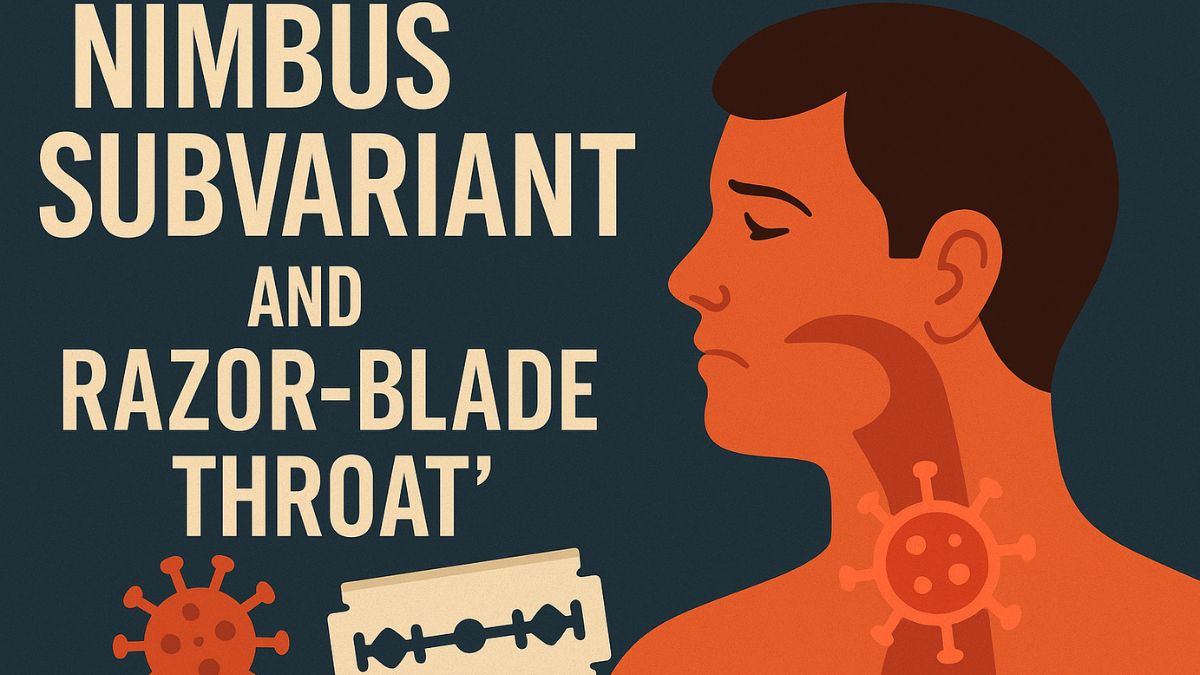New York: Picture this: you wake up with a scratchy throat, but as the day goes on, it feels like shards of glass are pressing on your tonsils. That’s the intense “razor‑blade throat” symptom making headlines—and it’s tied to a new COVID‑19 subvariant nicknamed Nimbus.
It’s been creeping into airwaves, group chats, and anxiety‑spiral memes like wildfire. While most cases remain mild, that stabbing scratch in your throat has everyone suddenly paying attention again—and wondering what comes next.
Here’s the heart of it: Nimbus (NB.1.8.1) spreads faster than previous variants, brings back vivid throat pain, but—fortunately—it’s not more dangerous in terms of hospitalizations or severity. Still, that pain? It’s real, emotionally jarring, and deserves some unpacking.
What Is the Nimbus COVID Variant?
Rising Subvariant NB.1.8.1 and “razor‑blade throat”
Nimbus, officially NB.1.8.1, is the latest subvariant in the Omicron family. In late April it accounted for ~2.5% of global cases; by late May–early June, that surged to over 10% globally and roughly 37% in the U.S. The World Health Organization now lists it as a “variant under monitoring” since May 23.
Why You’re Hearing “Razor‑Blade Throat”
A defining feature of Nimbus is its extremely painful throat symptom—patients describe swallowing shards of glass. This isn’t unique to this variant—but the collective buzz has amplified it. It’s been reported in California, Massachusetts, across Asia, Europe, and North America.
In California, tests show wastewater levels and positivity rates have ticked up (from about 1.1% in March to 2.8% in June), yet hospitalizations have stayed low.
Also Read: New COVID Variant Symptoms 2025: What to Know and How It’s Different From a Cold or Flu
Symptoms to Watch (Beyond the Razor‑Blade Pain)
Here’s a snapshot of Nimbus‑related symptoms:
| Symptom | Commonality |
| Intense sore throat (“razor‑blade”) |
Prominent — described by many sufferers
|
| Cough, congestion, mild fever |
Frequent with Nimbus and Omicron patterns
|
| Fatigue, body aches, headache |
Consistent with typical COVID waves
|
| Less common: diarrhea, nausea |
Reported in some cases
|
Note: Loss of taste/smell is less prominent than earlier COVID versions .
Is Nimbus More Dangerous?
Good news: No dramatic increase in severe cases or deaths has been linked to Nimbus.
- Hospitalization rates remain steady.
- WHO and experts confirm current vaccines still offer protection from serious illness.
- Most infections mirror Omicron’s mild impact despite being uncomfortable,
Still, older adults and immunocompromised individuals remain at higher risk—making vaccination and smart safety habits essential.
How to Protect Yourself
Vaccines & Boosters
Stay updated with boosters—health agencies affirm that 2024‑25 COVID shots are effective against Nimbus.
Everyday Safety
- Mask up in crowded or poorly ventilated spaces.
- Wash hands frequently.
- Consider testing before gatherings or travel.
Handling the Razor‑Blade Pain
If you catch Nimbus:
- Warm tea with honey, lozenges, and salt‑water gargles can soothe the throat.
- Over‑the‑counter ibuprofen or acetaminophen can ease pain and inflammation.
- Hydrate well—even small sips help when swallowing hurts.
If symptoms persist beyond a few days, seek medical advice—especially if breathing gets harder or fever stays high.
What This Means for You
- Don’t panic. Nimbus doesn’t appear more severe overall.
- Be “COVID street smart.” Smooth travel and summer gatherings coexist with smart precautions
- Listen to your body. That throat pain may be your early warning—don’t ignore it.
Nimbus (NB.1.8.1) is a mild‐severity yet highly contagious Omicron subvariant. Its distinctive “razor‑blade throat” is uncomfortable, but vaccines and self‑care go a long way toward managing illness and preventing spread. For people, layering awareness with smart habits ensures summer plans go off without a COVID hitch.







